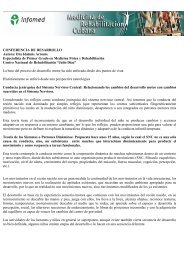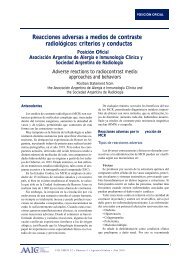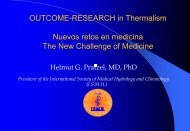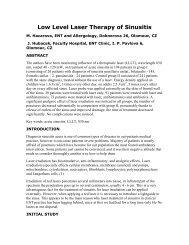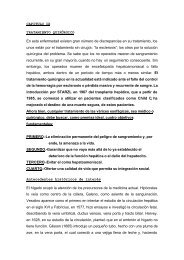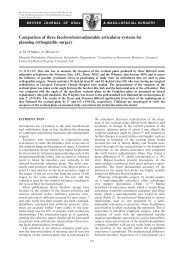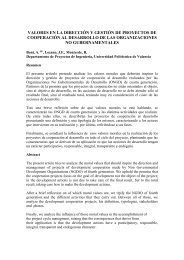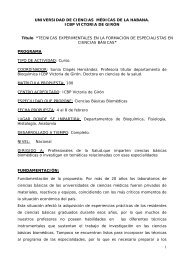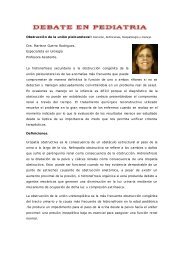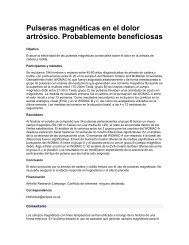pharmacology of medicinal plants and natural products
pharmacology of medicinal plants and natural products
pharmacology of medicinal plants and natural products
You also want an ePaper? Increase the reach of your titles
YUMPU automatically turns print PDFs into web optimized ePapers that Google loves.
MEDICINAL PLANTS (NATURAL PRDUCTS)<br />
S87<br />
Semecarpus anacardium (Bhallatak, nut shell) extract<br />
also exhibited hypocholesterolemic action <strong>and</strong><br />
prevented cholesterol induced atheroma in hypercholesterolaemic<br />
rabbits 60 . Similarly, Terminalia<br />
belerica (Bibhitak) reduced the levels <strong>of</strong> lipids in experimentally<br />
induced hypercholesterolaemia in rabbits.<br />
There was also a significant decrease in liver<br />
<strong>and</strong> heart lipids 61 .<br />
Administration <strong>of</strong> ethanolic extract (50% v/v) <strong>of</strong> Plumbago<br />
zeylanica (Chitrak) root, alone <strong>and</strong> in combination<br />
with vitamin E, significantly reduced serum total<br />
cholesterol, LDL cholesterol <strong>and</strong> triglyceride levels<br />
in experimentally induced hyperlipidaemic rabbits 62 .<br />
However, Dwivedi 63 pointed out that the ethanolic extract<br />
<strong>of</strong> Plumbago zeylanica root alone <strong>and</strong> with vitamin<br />
E lowered HDL cholesterol levels as well. Hence,<br />
he has advised caution about its use in patients <strong>and</strong><br />
confirmation <strong>of</strong> these findings through larger sample<br />
size studies.<br />
Administration <strong>of</strong> cell culture extract <strong>of</strong> Hemidesmus<br />
indicus (Sariva) in rats also receiving an atherogenic<br />
diet prevented hypercholesterolaemia 64 .<br />
4.3. Anti-hypertensives<br />
Preparation <strong>of</strong> the whole plant <strong>of</strong> Phyllanthus amarus<br />
(Bhuiamalaki) was administered to 9 mild hypertensive<br />
subjects for 10 days. The results suggest that it<br />
is a potential diuretic, hypotensive <strong>and</strong> hypoglycemic<br />
drug for humans 65 .<br />
Hydroalcoholic leaf extract <strong>of</strong> Azadirachta indica<br />
caused a dose-dependent hypotensive effect. It did<br />
not alter the force <strong>of</strong> contraction or heart rate at low<br />
doses in isolated frog heart, but caused a temporary<br />
cardiac arrest in diastolic at high doses 66 .<br />
The petroleum ether extract <strong>of</strong> Abies pindrow leaf<br />
showed significant hypotensive effect in anaesthetized<br />
dogs 19 .<br />
Treatment with Abana, a polyherbal formulation, in<br />
normotensive rats produced significant lowering <strong>of</strong><br />
blood pressure, enhancement <strong>of</strong> vaso-pressor responses<br />
to low dose <strong>of</strong> noradrenaline (with no effect<br />
on dopamine β hydroxylase activity) <strong>and</strong> no effect<br />
on the vaso-depressor responses <strong>of</strong> acetylcholine<br />
<strong>and</strong> isoprenaline. It, however, protected against<br />
ethinyl oestradiol induced hypertension <strong>and</strong> increased<br />
dopamine β hydroxylase activity in these<br />
hypertensive animals, thus suggesting that it produces<br />
effects against ethinyl oestradiol induced hypertension<br />
by its sympatholytic property 67 .<br />
4.4. ACE (angiotensin converting enzyme) inhibitors<br />
Seventy- five species <strong>of</strong> traditional <strong>medicinal</strong> <strong>plants</strong><br />
belonging to 42 families have been investigated for<br />
their ability to inhibit the angiotensin converting enzyme.<br />
Of these, 4 species were found to possess a<br />
high ACE inhibiting ability <strong>and</strong> were low in their tannin<br />
content 68 .<br />
4.5. Cardio-protectives<br />
Rutin, a flavonoid, obtained from the plant, Sophora<br />
japonica, markedly reduced the infarct size <strong>and</strong> prevented<br />
the loss <strong>of</strong> the ‘R’ wave in anaesthetized rats<br />
subjected to coronary artery ligation. It, however, had<br />
no effect on heart rate <strong>and</strong> systolic blood pressure. It<br />
also reduced the ligation-induced increase in serum<br />
malonyldialdehyde levels <strong>and</strong> prevented the loss <strong>of</strong><br />
glutathione peroxidase activity. Rutin inhibited, in vitro,<br />
luminol-induced chemiluminescence <strong>of</strong> rat PMN’s,<br />
thus indicating that its beneficial effect is probably<br />
due to its ability to impair the generation <strong>of</strong> reactive<br />
oxygen species 69 .<br />
4.6. Positive ionotropics<br />
Vaidya 70 in his editorial, had raised the issue on the<br />
controversies that exist regarding ionotropic actions<br />
<strong>of</strong> Terminalia arjuna (Arjuna). Though there are studies<br />
proving positive ionotropic effects <strong>of</strong> this plant,<br />
some scientists have observed negative ionotropic<br />
<strong>and</strong> chronotropic effects as well. Hence, he had advised<br />
more detailed experimental <strong>and</strong> clinical studies<br />
on the plant <strong>and</strong> its active principle. Data <strong>of</strong> placebo-controlled<br />
clinical studies carried out subsequently<br />
with this plant is presented below.<br />
When the bark extract <strong>of</strong> Terminalia arjuna was compared<br />
to placebo in 12 patients with refractory CCF<br />
in a phase II clinical trial, it was observed that treatment<br />
with Terminalia arjuna was associated with an<br />
improvement in symptoms <strong>and</strong> signs <strong>of</strong> heart failure,<br />
improvement in the NYHA class (from IV & III), decrease<br />
in echo-left ventricular end-diastolic <strong>and</strong> endsystolic<br />
volumes indices, increase in the left ventricular<br />
stroke volume index <strong>and</strong> increase in left ventricular<br />
ejection fraction at the end <strong>of</strong> 2 weeks. Long term<br />
therapy (i.e. 24 months) too showed continued




